Attached files
| file | filename |
|---|---|
| 8-K - CYTORI8K11216 - PLUS THERAPEUTICS, INC. | cytori8511216.htm |
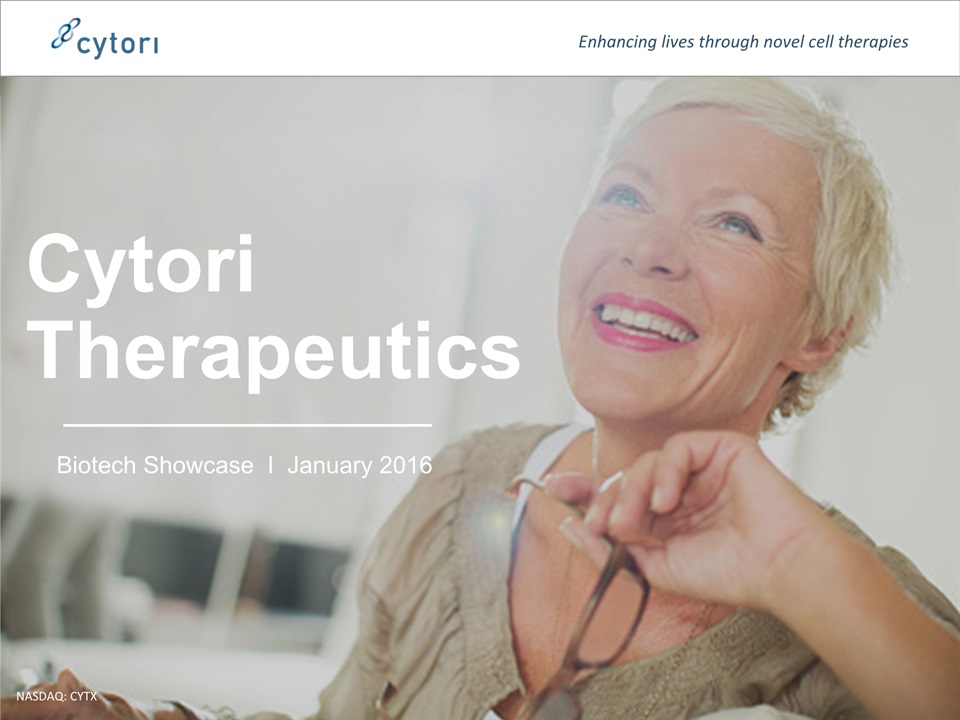
Cytori Therapeutics NASDAQ: CYTX Enhancing lives through novel cell therapies Biotech Showcase I January 2016

Forward Looking Statements and Disclaimers 33% 15% 11% 22% 19% OTHER USA EU JAPAN ASIA-PACIFIC This presentation contains certain ‘forward-looking statements’ about Cytori Therapeutics, Inc. All statements, other than statements of historical fact, that address activities, events or developments that we intend, expect, project, believe or anticipate will or may occur in the future are forward-looking statements. Such statements are based upon certain assumptions and assessments made by our management in light of their experience and their perception of historical trends, current conditions, expected future developments and other factors they believe to be appropriate. The forward-looking statements included in this presentation, involve known and unknown risks that relate to future events or our future financial performance and the actual results could differ materially from those discussed in this presentation. Some of those forward-looking statements include: our commercialized and pipeline products and technologies; the timing and conduct of our clinical trials, and the associated financial, clinical and regulatory burdens; other parties’ abilities to conduct clinical trials involving Cytori Cell Therapy; the various medical indications and markets that may be addressed by Cytori Cell Therapy; the potential effectiveness of Cytori Cell Therapy, including clinical outcomes; our regulatory, reimbursement and commercial strategies and pathways; potential costs and other adverse effects of diseases targeted for treatment by our products, and; anticipated future funding and contract revenues. Some risks and uncertainties related to such forward looking statements include risks and uncertainties regarding the funding, conduct and completion of our clinical trials and other parties’ clinical trials involving Cytori Cell therapy, uncertain clinical outcomes, regulatory uncertainties, unfavorable reimbursement outcomes, inability to access sufficient capital on acceptable terms (including inability to fund, or find third party sources to fund, our proposed clinical trials or continued development of our technologies), failure to maintain our substantially reduced cash burn; our partners’ failure to launch products in China and other markets where we currently forecast sales; our abilities to service, pay and/or refinance our corporate debt; availability of future government funding and changes in government procurement priorities; the U.S. federal government’s ability to reduce, modify or terminate the BARDA contract if it determines it is in its best interests to do so, potential performance issues with our products and technologies, and other risks and uncertainties described under the "Risk Factors" section in our Securities and Exchange Commission Filings on Form 10-K and Form 10-Q. These risks and uncertainties may cause our actual results to differ materially from those discussed in this presentation. We advise reading our most recent annual report on Form 10-K and quarterly report on Form 10-Q filed with the United States Securities and Exchange Commission for a more detailed description of these risks.The forward-looking statements contained in this presentation represent our estimates and assumptions only as of the date of this presentation and we undertake no duty or obligation to update or revise publicly any forward-looking statements contained in this presentation as a result of new information, future events or changes in our expectations.DisclaimersCaution: Within the U.S., the Celution System is an investigational device limited by U.S. law to investigational use.Celase, Celution, Celution (with design), Cytori Therapeutics, and Cytori (with design) are registered trademarks of Cytori Therapeutics. Cytori Cell Therapy is a trademark of Cytori Therapeutics. All third party trademarks are the property of their respective owners. 2 1/10/16
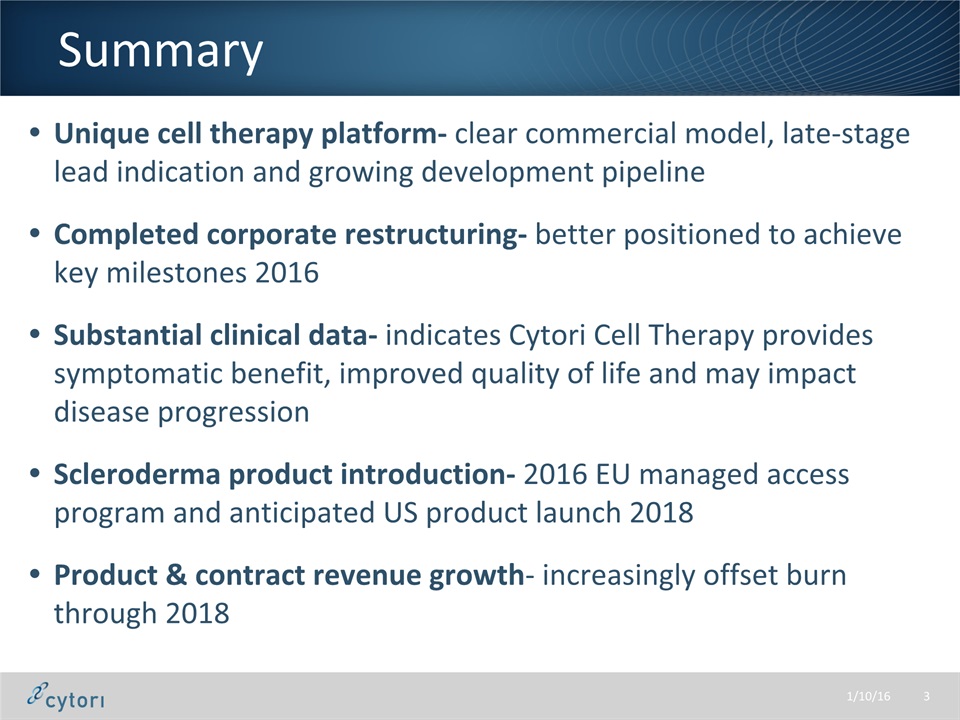
Summary Unique cell therapy platform- clear commercial model, late-stage lead indication and growing development pipeline Completed corporate restructuring- better positioned to achieve key milestones 2016Substantial clinical data- indicates Cytori Cell Therapy provides symptomatic benefit, improved quality of life and may impact disease progressionScleroderma product introduction- 2016 EU managed access program and anticipated US product launch 2018Product & contract revenue growth- increasingly offset burn through 2018 3 1/10/16
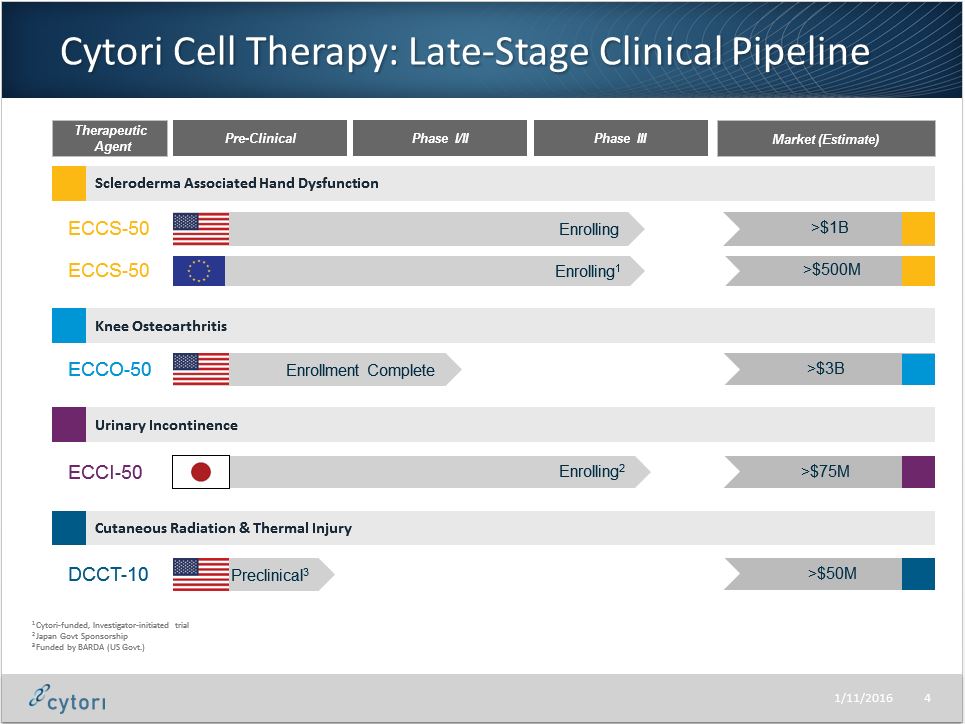
Enrolling2 Cytori Cell Therapy: Late-Stage Clinical Pipeline ECCI-50 Enrollment Complete ECCO-50 Preclinical3 DCCT-10 Enrolling ECCS-50 Enrolling1 ECCS-50 Pre-Clinical Phase I/II Phase III Market (Estimate) >$1B >$500M >$3B >$75M >$50M 1 Cytori-funded, Investigator-initiated trial2 Japan Govt Sponsorship3 Funded by BARBA (US Govt.) Scleroderma Associated Hand Dysfunction Knee Osteoarthritis Urinary Incontinence Cutaneous Radiation & Thermal Injury Therapeutic Agent 4 1/10/16

Cytori 3-Step Bedside Process TIME 30 Min 120 Min 5 - 30 Min PROCESS HARVESTSmall Volume Liposuction(100-360 mL) PROCESSCelution® SystemTissue Processing, Cell Isolation & Dose Preparation DELIVERCytori® Cell TherapyTM Delivery Bedside Manufactureproprietary consumables,software, and reagents Adipose Tissue Non-Viable Cellular Debris, Waste & Enzymes Adipose Derived Regenerative Cells(ADRCs) Hand Scleroderma Knee Osteoarthritis 5 1/10/16 1 2 3
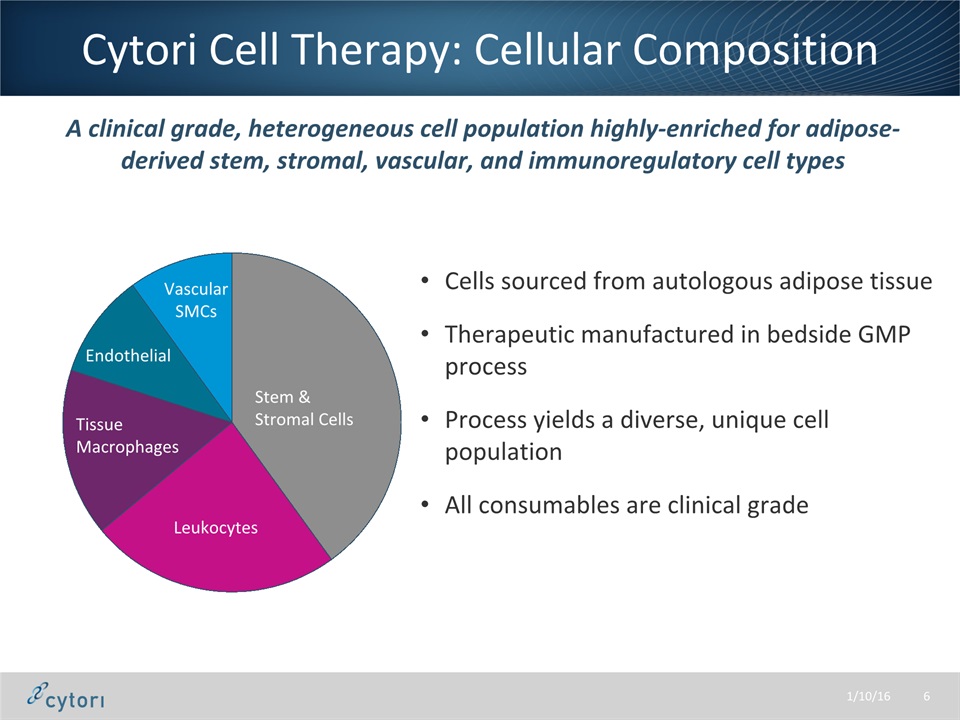
Cytori Cell Therapy: Cellular Composition Cells sourced from autologous adipose tissueTherapeutic manufactured in bedside GMP processProcess yields a diverse, unique cell populationAll consumables are clinical grade Stem & Stromal Cells Leukocytes Tissue Macrophages Endothelial VascularSMCs A clinical grade, heterogeneous cell population highly-enriched for adipose-derived stem, stromal, vascular, and immunoregulatory cell types 6 1/10/16
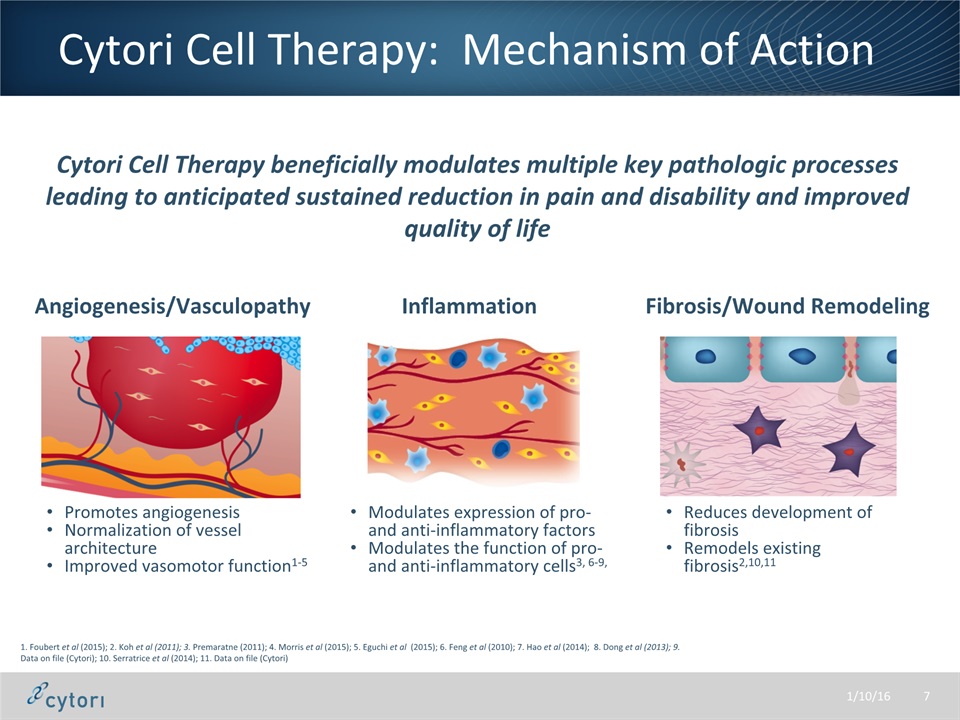
Cytori Cell Therapy: Mechanism of Action Cytori Cell Therapy beneficially modulates multiple key pathologic processes leading to anticipated sustained reduction in pain and disability and improved quality of life Promotes angiogenesisNormalization of vessel architectureImproved vasomotor function1-5 Reduces development of fibrosisRemodels existing fibrosis2,10,11 Modulates expression of pro- and anti-inflammatory factorsModulates the function of pro- and anti-inflammatory cells3, 6-9, 1. Foubert et al (2015); 2. Koh et al (2011); 3. Premaratne (2011); 4. Morris et al (2015); 5. Eguchi et al (2015); 6. Feng et al (2010); 7. Hao et al (2014); 8. Dong et al (2013); 9. Data on file (Cytori); 10. Serratrice et al (2014); 11. Data on file (Cytori) Inflammation Fibrosis/Wound Remodeling Angiogenesis/Vasculopathy 7 1/10/16
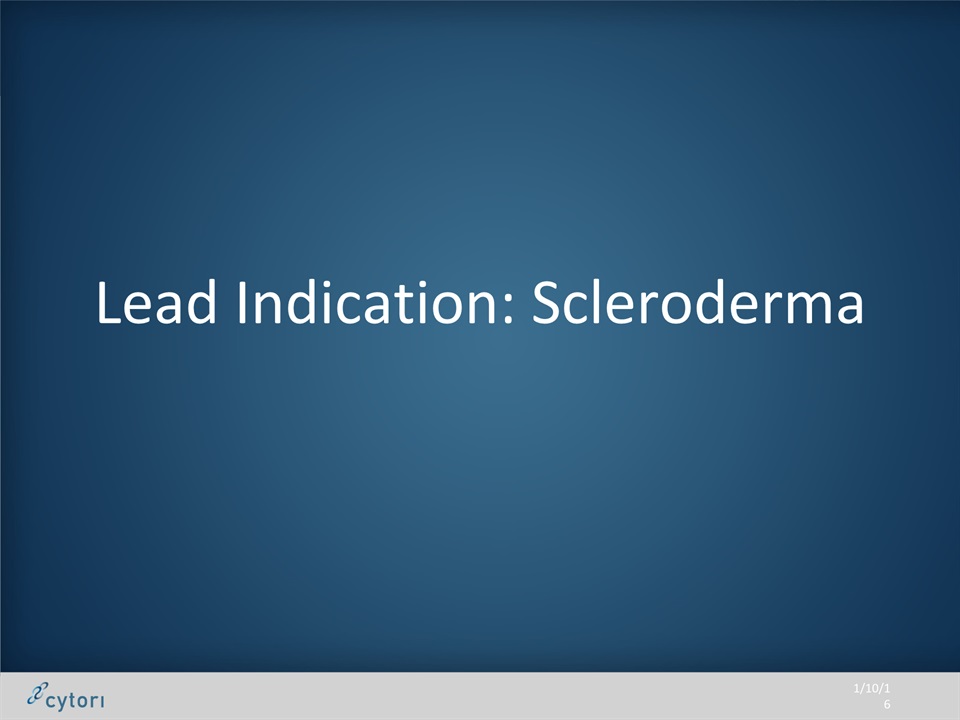
Lead Indication: Scleroderma
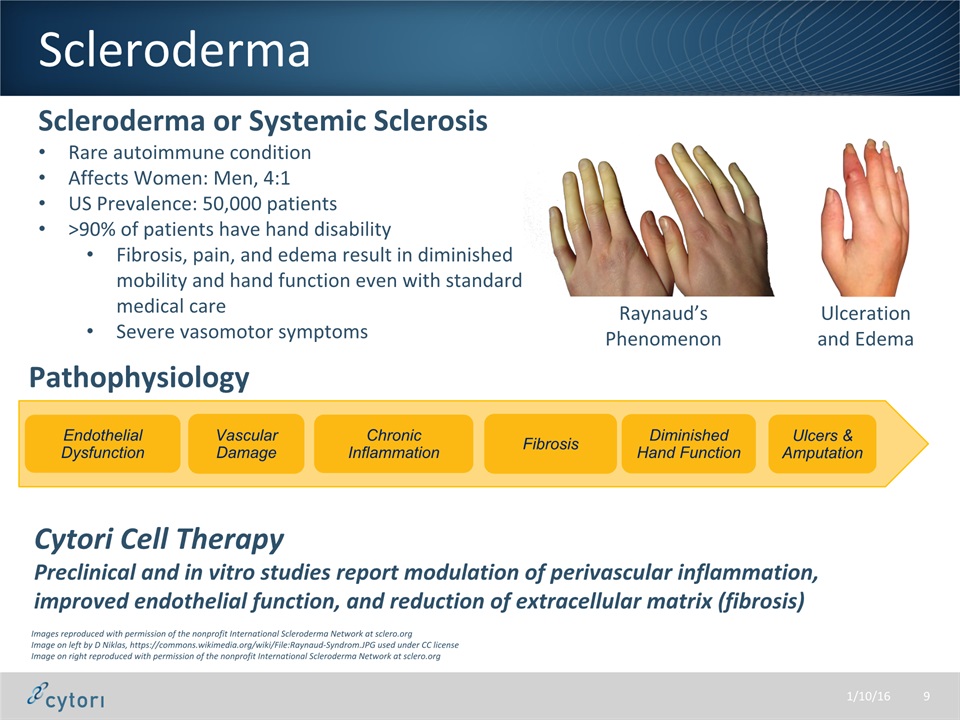
Scleroderma Pathophysiology Scleroderma or Systemic SclerosisRare autoimmune conditionAffects Women: Men, 4:1US Prevalence: 50,000 patients>90% of patients have hand disabilityFibrosis, pain, and edema result in diminished mobility and hand function even with standard medical careSevere vasomotor symptoms Cytori Cell TherapyPreclinical and in vitro studies report modulation of perivascular inflammation, improved endothelial function, and reduction of extracellular matrix (fibrosis) Images reproduced with permission of the nonprofit International Scleroderma Network at sclero.orgImage on left by D Niklas, https://commons.wikimedia.org/wiki/File:Raynaud-Syndrom.JPG used under CC licenseImage on right reproduced with permission of the nonprofit International Scleroderma Network at sclero.org Raynaud’s Phenomenon Ulceration and Edema 9 1/10/16
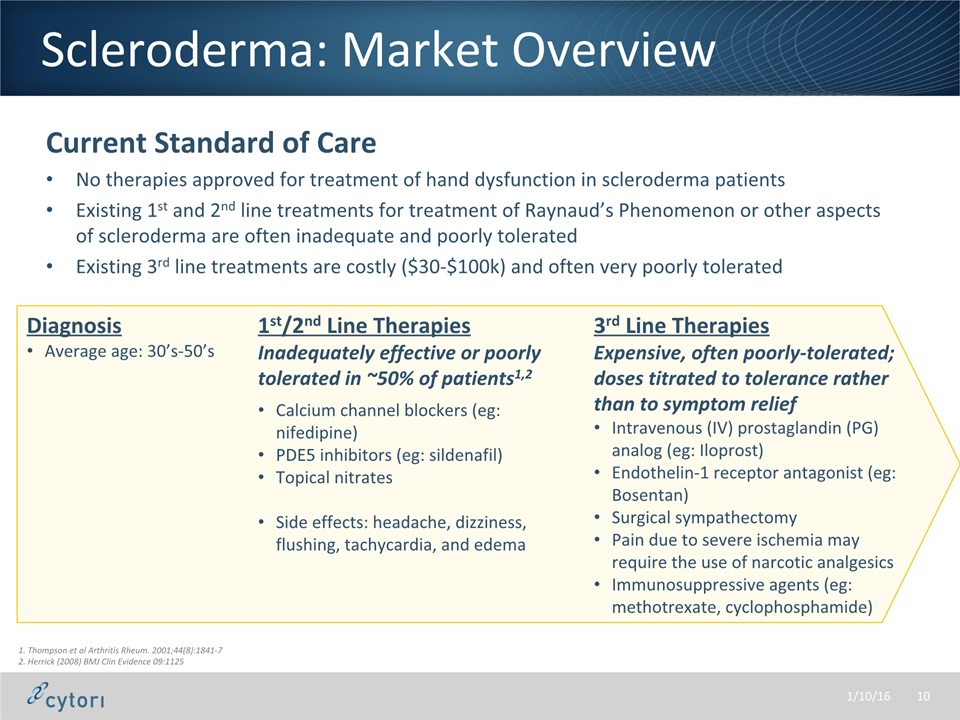
Scleroderma: Market Overview Current Standard of CareNo therapies approved for treatment of hand dysfunction in scleroderma patientsExisting 1st and 2nd line treatments for treatment of Raynaud’s Phenomenon or other aspects of scleroderma are often inadequate and poorly toleratedExisting 3rd line treatments are costly ($30-$100k) and often very poorly tolerated DiagnosisAverage age: 30’s-50’s 1st/2nd Line TherapiesInadequately effective or poorly tolerated in ~50% of patients1,2Calcium channel blockers (eg: nifedipine)PDE5 inhibitors (eg: sildenafil)Topical nitratesSide effects: headache, dizziness, flushing, tachycardia, and edema 3rd Line TherapiesExpensive, often poorly-tolerated;doses titrated to tolerance rather than to symptom reliefIntravenous (IV) prostaglandin (PG) analog (eg: Iloprost)Endothelin-1 receptor antagonist (eg: Bosentan)Surgical sympathectomyPain due to severe ischemia may require the use of narcotic analgesicsImmunosuppressive agents (eg: methotrexate, cyclophosphamide) 1. Thompson et al Arthritis Rheum. 2001;44(8):1841-72. Herrick (2008) BMJ Clin Evidence 09:1125 10 1/10/16

Scleroderma: Treatment Approach AmbulatoryProcedure roomLocal or mild conscious sedationSingle administration ECCS-500.5cc injection to each NVBNo bandage \ 11 1/10/16
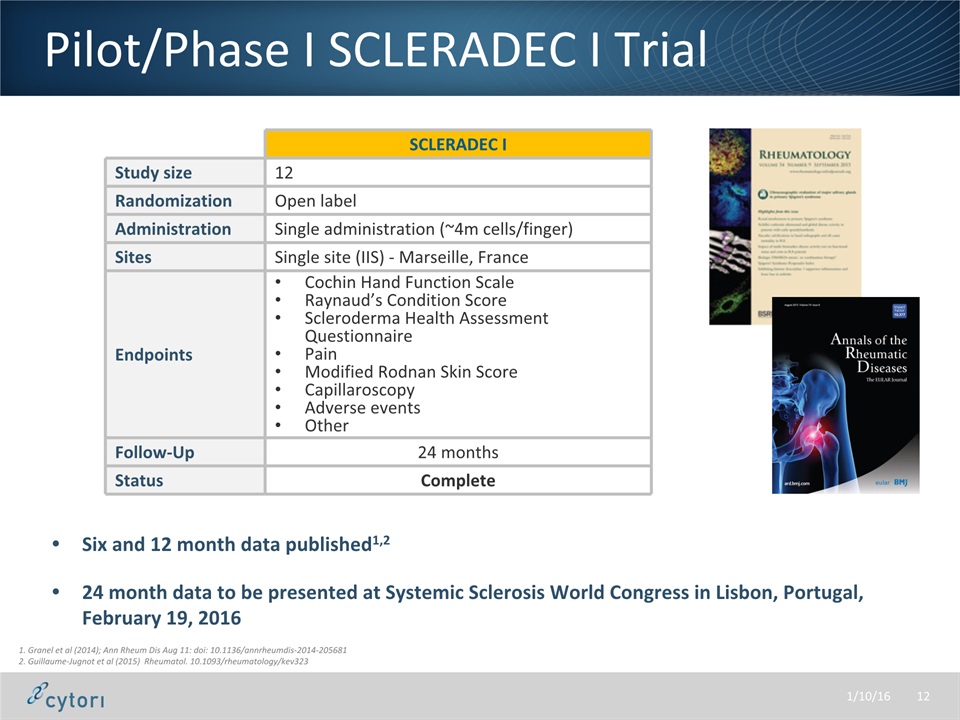
Pilot/Phase I SCLERADEC I Trial SCLERADEC I Study size 12 Randomization Open label Administration Single administration (~4m cells/finger) Sites Single site (IIS) - Marseille, France Endpoints Cochin Hand Function ScaleRaynaud’s Condition ScoreScleroderma Health Assessment QuestionnairePain Modified Rodnan Skin ScoreCapillaroscopy Adverse eventsOther Follow-Up 24 months Status Complete Six and 12 month data published1,224 month data to be presented at Systemic Sclerosis World Congress in Lisbon, Portugal, February 19, 2016 1. Granel et al (2014); Ann Rheum Dis Aug 11: doi: 10.1136/annrheumdis-2014-2056812. Guillaume-Jugnot et al (2015) Rheumatol. 10.1093/rheumatology/kev323 12 1/10/16
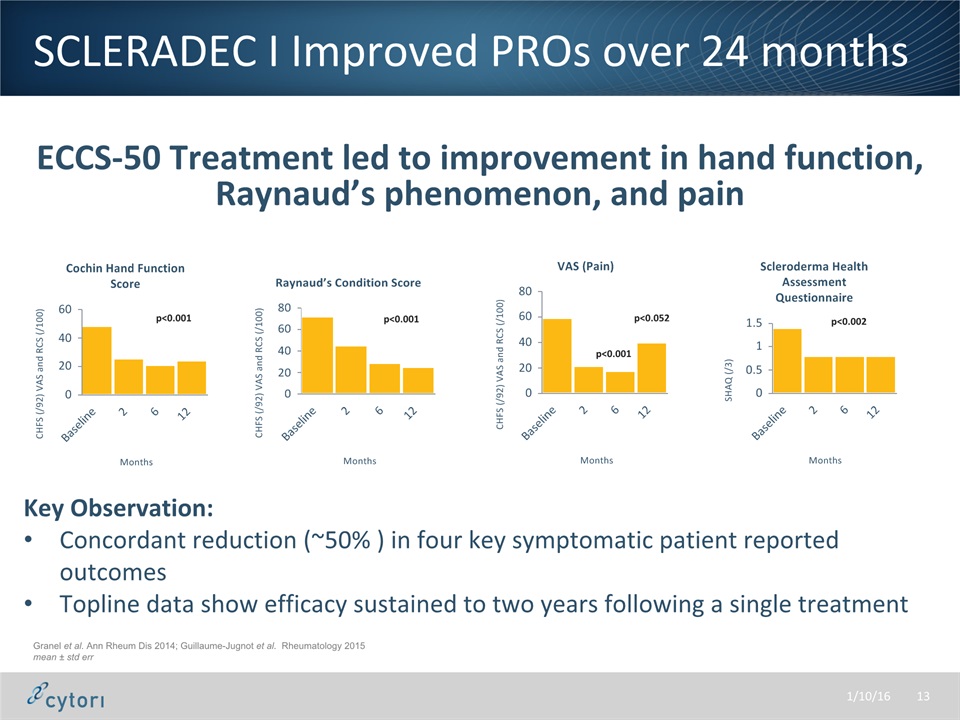
ECCS-50 Treatment led to improvement in hand function, Raynaud’s phenomenon, and pain SCLERADEC I Improved PROs over 24 months Granel et al. Ann Rheum Dis 2014; Guillaume-Jugnot et al. Rheumatology 2015mean ± std err Key Observation:Concordant reduction (~50% ) in four key symptomatic patient reported outcomesTopline data show efficacy sustained to two years following a single treatment p<0.001 p<0.001 p<0.001 p<0.052 p<0.002 13 1/10/16
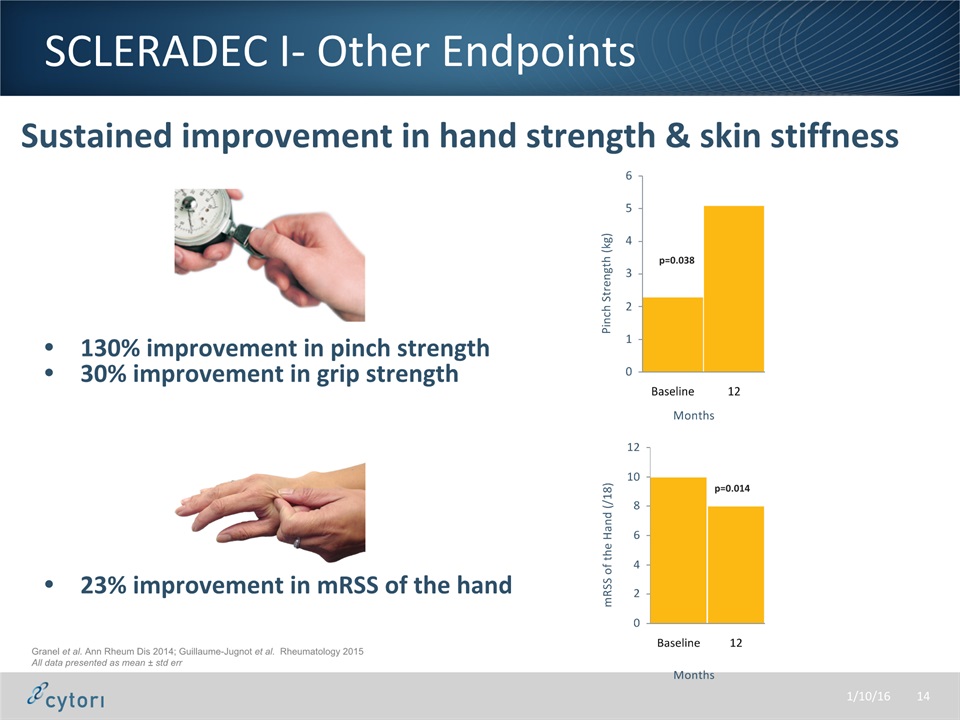
SCLERADEC I- Other Endpoints Granel et al. Ann Rheum Dis 2014; Guillaume-Jugnot et al. Rheumatology 2015All data presented as mean ± std err Sustained improvement in hand strength & skin stiffness 130% improvement in pinch strength30% improvement in grip strength p=0.014 23% improvement in mRSS of the hand 14 p=0.038 1/10/16
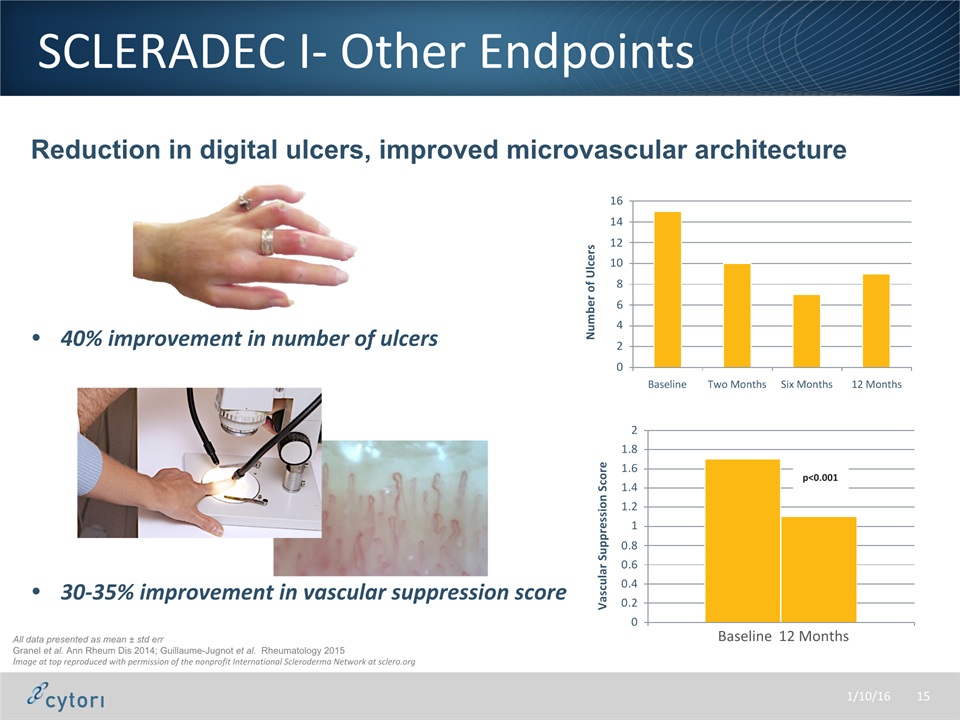
Reduction in digital ulcers, improved microvascular architecture All data presented as mean ± std errGranel et al. Ann Rheum Dis 2014; Guillaume-Jugnot et al. Rheumatology 2015Image at top reproduced with permission of the nonprofit International Scleroderma Network at sclero.org SCLERADEC I- Other Endpoints 30-35% improvement in vascular suppression score 40% improvement in number of ulcers Baseline 12 Months p<0.001 15 1/10/16
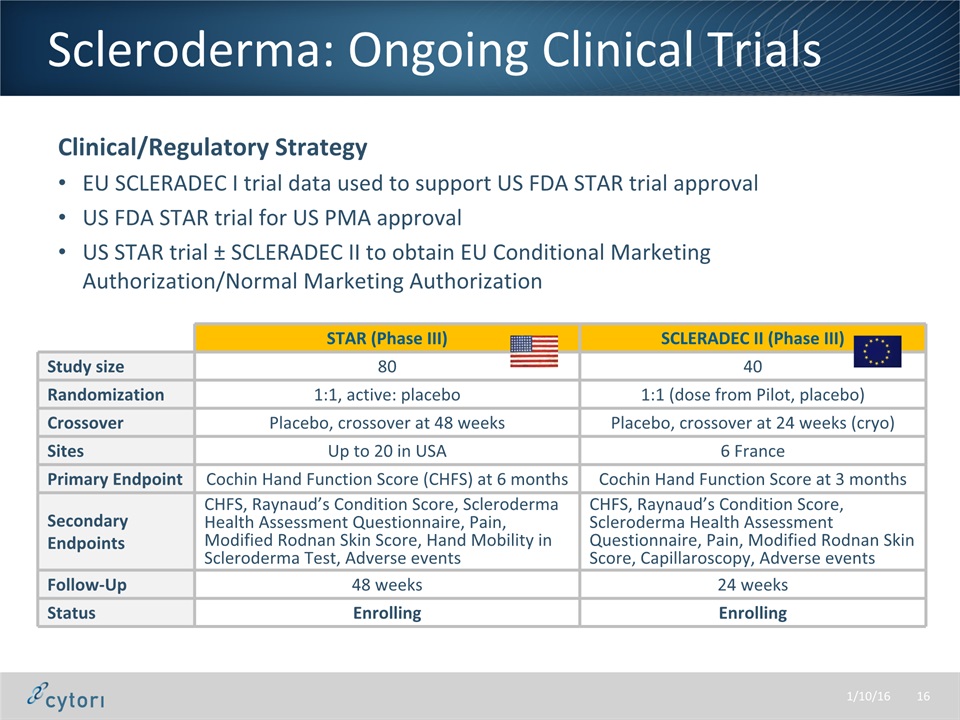
Scleroderma: Ongoing Clinical Trials STAR (Phase III) SCLERADEC II (Phase III) Study size 80 40 Randomization 1:1, active: placebo 1:1 (dose from Pilot, placebo) Crossover Placebo, crossover at 48 weeks Placebo, crossover at 24 weeks (cryo) Sites Up to 20 in USA 6 France Primary Endpoint Cochin Hand Function Score (CHFS) at 6 months Cochin Hand Function Score at 3 months Secondary Endpoints CHFS, Raynaud’s Condition Score, Scleroderma Health Assessment Questionnaire, Pain, Modified Rodnan Skin Score, Hand Mobility in Scleroderma Test, Adverse events CHFS, Raynaud’s Condition Score, Scleroderma Health Assessment Questionnaire, Pain, Modified Rodnan Skin Score, Capillaroscopy, Adverse events Follow-Up 48 weeks 24 weeks Status Enrolling Enrolling Clinical/Regulatory StrategyEU SCLERADEC I trial data used to support US FDA STAR trial approvalUS FDA STAR trial for US PMA approvalUS STAR trial ± SCLERADEC II to obtain EU Conditional Marketing Authorization/Normal Marketing Authorization 16 1/10/16

Scleroderma: Anticipated Development Timeline 2015 2016 2017 2018 2019 3 4 1 2 3 4 1 2 3 4 1 2 3 4 1 2 3 4 STAR Enrollment, 12 Month Follow-Up & Data Analysis FDA Original PMA Submission & Panel Approval Reimbursement Scleradec II Enrollment,6 Month Follow-Up & Data Analysis Reimbursement EMA MAA Submission for Full Marketing Authorization(based on SCLERADEC I/II and STAR) Approval Phase III Data Reimbursement Conditional Approval EU Phase III Data Reimbursement Full Approval EMA Conditional MAA Submission for(based on SCLERADEC I/II) 17 Device (PMA) Drug (ATMP) 1/10/16
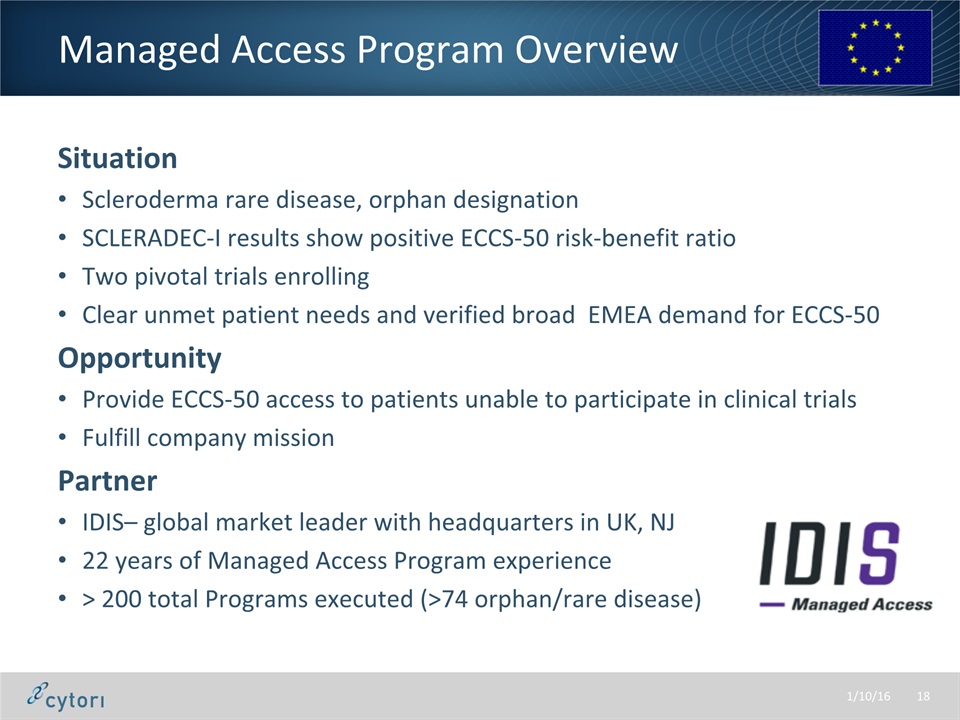
Managed Access Program Overview SituationScleroderma rare disease, orphan designationSCLERADEC-I results show positive ECCS-50 risk-benefit ratioTwo pivotal trials enrollingClear unmet patient needs and verified broad EMEA demand for ECCS-50OpportunityProvide ECCS-50 access to patients unable to participate in clinical trialsFulfill company missionPartnerIDIS– global market leader with headquarters in UK, NJ22 years of Managed Access Program experience> 200 total Programs executed (>74 orphan/rare disease) 18 1/10/16
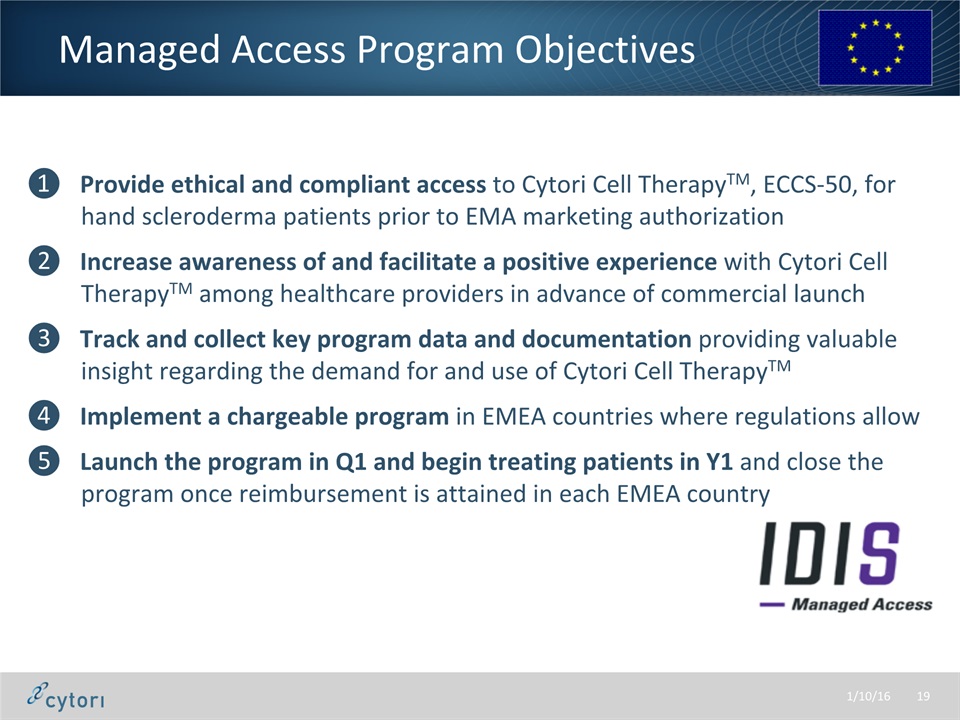
Managed Access Program Objectives ❶ Provide ethical and compliant access to Cytori Cell TherapyTM, ECCS-50, for hand scleroderma patients prior to EMA marketing authorization ❷ Increase awareness of and facilitate a positive experience with Cytori Cell TherapyTM among healthcare providers in advance of commercial launch❸ Track and collect key program data and documentation providing valuable insight regarding the demand for and use of Cytori Cell TherapyTM ❹ Implement a chargeable program in EMEA countries where regulations allow❺ Launch the program in Q1 and begin treating patients in Y1 and close the program once reimbursement is attained in each EMEA country 19 1/10/16

Scleroderma Anticipated Managed Access Program Timeline 2015 2016 2017 2018 2019 2020 2021 3 4 1 2 3 4 1 2 3 4 1 2 3 4 1 2 3 4 1 2 3 4 1 2 SCLERADEC-II French Clinical Study EMA Conditional MAA Submission(based on SCLERADEC-II) Reimbursement Applications EMA Full MAA Submission (based on SCLERADEC-II and STAR) Conditional EMA Approval 6 Month Data Full EMA Approval 12 Month Data STARU.S. Clinical Study Country-by-Country Reimbursement Approval 1st Patient Treated ProgramDesign & Set UpPricing Strategy Access & Billing in Most EMEA Countries Country Expansion Peak Adoption Access & Billing in CRO, CZE, GER, HUN, ITA, KSA, POL, RUS, SAU, TUR(based on Conditional EU Approval) DEVELOPMENT MAP Close Program Transition to Commercial Launch 20 1/10/16

Pipeline IndicationsKnee OsteoarthritisUrinary IncontinenceRadiation/Nuclear Burn
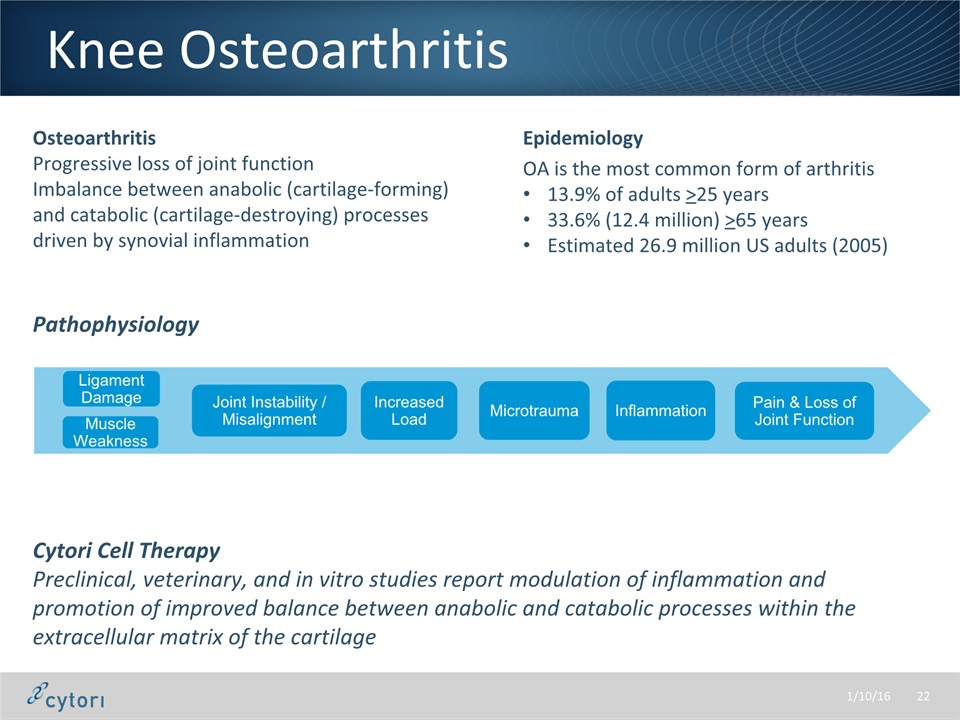
Knee Osteoarthritis OsteoarthritisProgressive loss of joint functionImbalance between anabolic (cartilage-forming) and catabolic (cartilage-destroying) processes driven by synovial inflammation EpidemiologyOA is the most common form of arthritis13.9% of adults >25 years33.6% (12.4 million) >65 yearsEstimated 26.9 million US adults (2005) Pathophysiology Cytori Cell TherapyPreclinical, veterinary, and in vitro studies report modulation of inflammation and promotion of improved balance between anabolic and catabolic processes within the extracellular matrix of the cartilage 22 1/10/16
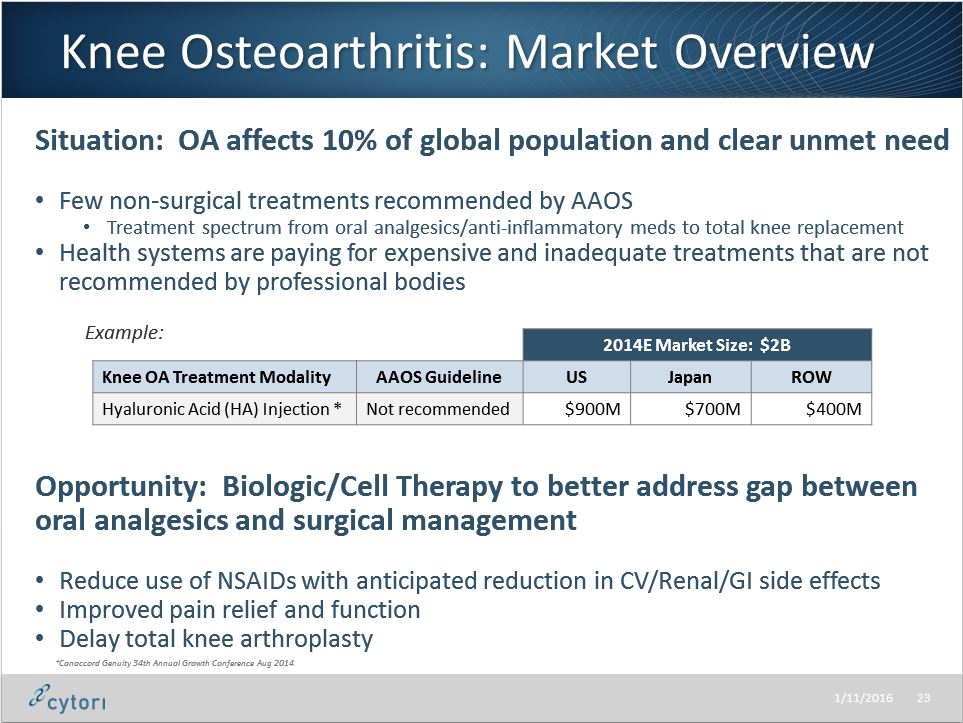
Knee Osteoarthritis: Market Overview 2014E Market Size: $2B Knee OA Treatment Modality AAOS Guideline US Japan ROW Hyaluronic Acid (HA) Injection * Not recommended $900M $700M $400M Situation: OA affects 10% of global population and clear unmet need Few non-surgical treatments recommended by AAOSTreatment spectrum from oral analgesics/anti-inflammatory meds to total knee replacementHealth systems are paying for expensive and inadequate treatments that are not recommended by professional bodiesOpportunity: Biologic/Cell Therapy to better address gap between oral analgesics and surgical managementReduce use of NSAIDs with anticipated reduction in CV/Renal/GI side effectsImproved pain relief and functionDelay total knee arthroplasty *Canaccord Genuity 34th Annual Growth Conference Aug 2014 Example: 23 1/10/16

Rationale for use of Cytori Cell Therapy in OA The pathophysiology of osteoarthritis (persistent synovial inflammation leading to cartilage destruction) overlaps with other clinical indications in which Cytori Cell Therapy shown to have impactCombination of veterinary, preclinical, in vitro, and pilot clinical data indicate significant potential for symptomatic improvement and perhaps disease modificationClinical feasibility proven 24 1/10/16

ACT-OA Enrolled Phase II Trial Phase II (ACT-OA) Study Size 94 Randomization 1:1:1 (low dose, high dose, placebo) Crossover None Sites 12 US Primary Endpoint KOOS - pain on walking Secondary Endpoints KOOS, pain/function questionnaires, pain meds, SF-36, MRI Follow-Up 48 weeks Status Enrolled24 wk data Q1/1548 week data Q4/15 Clinical/Regulatory StrategyUS FDA phase II to investigate safety and potential efficacy in key endpoints of single intrarticular administrationIf positive- possible additional phase II, development, or proceed to phase III 25 1/10/16
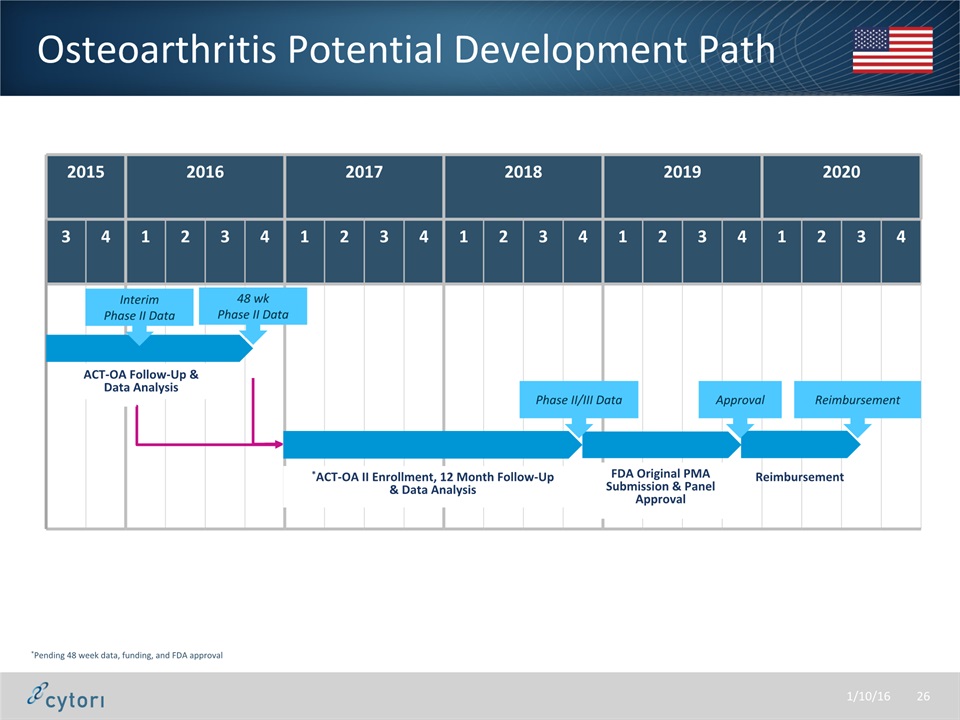
Osteoarthritis Potential Development Path *Pending 48 week data, funding, and FDA approval 26 2015 2016 2017 2018 2019 2020 3 4 1 2 3 4 1 2 3 4 1 2 3 4 1 2 3 4 1 2 3 4 ACT-OA Follow-Up & Data Analysis *ACT-OA II Enrollment, 12 Month Follow-Up& Data Analysis FDA Original PMA Submission & Panel Approval Reimbursement Approval Phase II/III Data Reimbursement Interim Phase II Data 48 wk Phase II Data 1/10/16

Stress Urinary Incontinence Program: Japan ‘ADRESU’ Trial ObjectivesApproved, reimbursed therapy for SUI in men following radical prostatectomySignificant unmet need for patients whose symptoms are not responding to conservative methods SupportIIS with support from Cytori and substantial funding via grant from the Japanese Ministry of Health, Labour and Welfare Progress/DataPilot clinical trial data published 1,2Increase in mean maximum urethral closing pressureReduction in mean 24-hour pad weightIncreased blood flowOngoing 45 pt. Multicenter Pivotal TrialEnrollment started Q3/20152 years to enroll Development PlanOngoing pivotal trial anticipated as combined approval and reimbursement trialAssuming positive data, seek approval and reimbursement based on 12 month assessmentSeeking commercial partnership with Japanese company 1. Gotoh et al. (2014) Int J Urology 21 (3) 294-3002. Yamamoto et al. (2012) Int J Urology 19 (7) 652-9 27 1/10/16
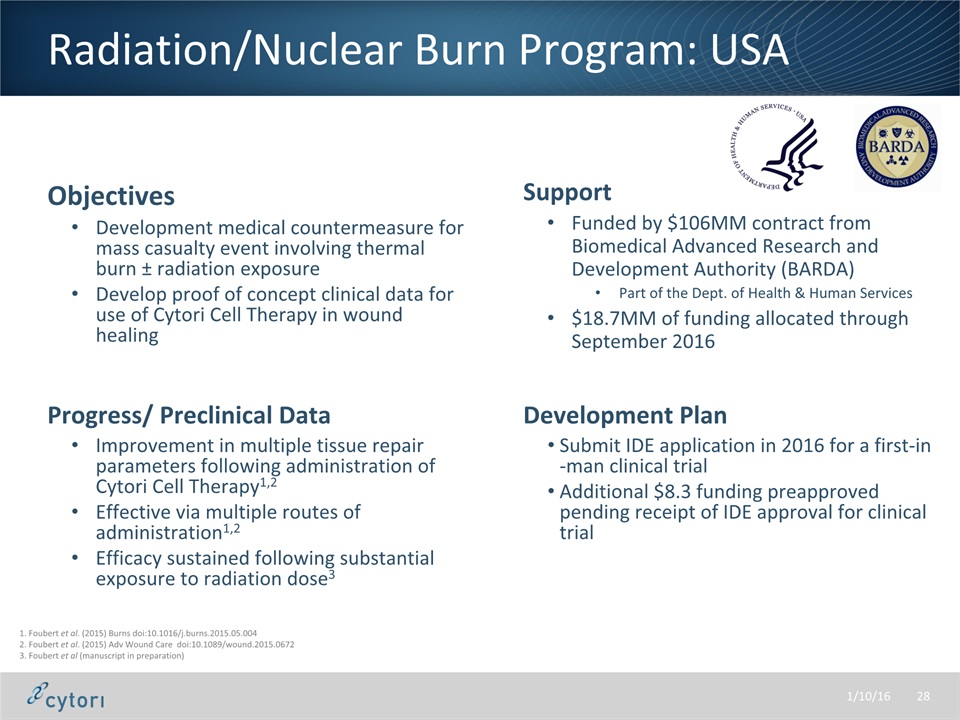
Radiation/Nuclear Burn Program: USA ObjectivesDevelopment medical countermeasure for mass casualty event involving thermal burn ± radiation exposure Develop proof of concept clinical data for use of Cytori Cell Therapy in wound healing SupportFunded by $106MM contract from Biomedical Advanced Research and Development Authority (BARDA)Part of the Dept. of Health & Human Services$18.7MM of funding allocated through September 2016 Progress/ Preclinical DataImprovement in multiple tissue repair parameters following administration of Cytori Cell Therapy1,2Effective via multiple routes of administration1,2Efficacy sustained following substantial exposure to radiation dose3 Development PlanSubmit IDE application in 2016 for a first-in-man clinical trialAdditional $8.3 funding preapproved pending receipt of IDE approval for clinical trial 1. Foubert et al. (2015) Burns doi:10.1016/j.burns.2015.05.0042. Foubert et al. (2015) Adv Wound Care doi:10.1089/wound.2015.06723. Foubert et al (manuscript in preparation) 28 1/10/16

Corporate Information
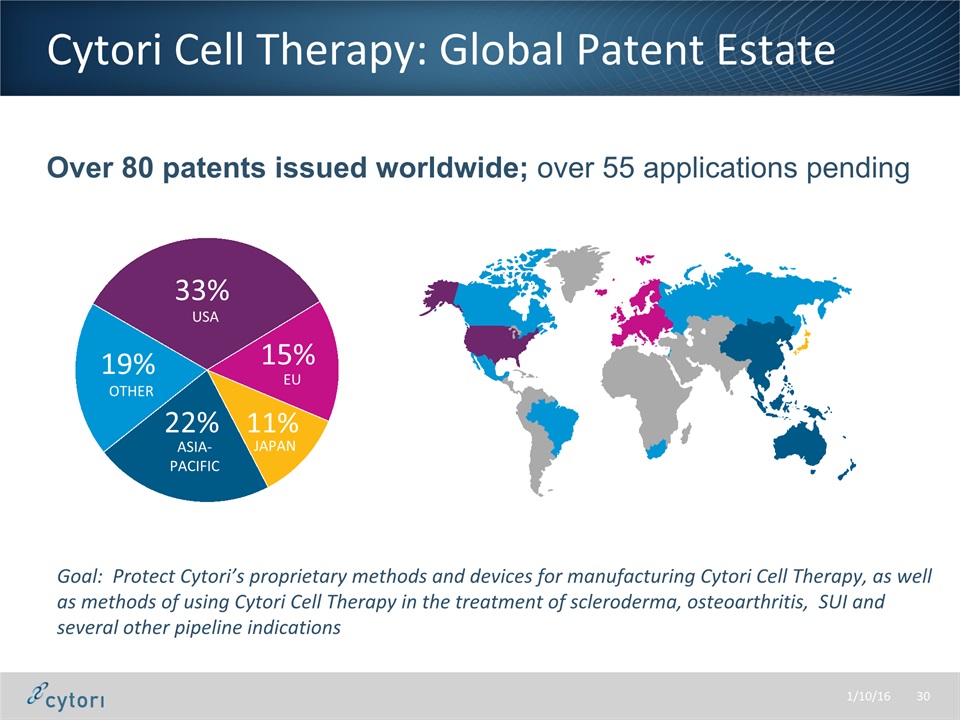
Over 80 patents issued worldwide; over 55 applications pending Cytori Cell Therapy: Global Patent Estate Goal: Protect Cytori’s proprietary methods and devices for manufacturing Cytori Cell Therapy, as well as methods of using Cytori Cell Therapy in the treatment of scleroderma, osteoarthritis, SUI and several other pipeline indications 33% 15% 11% 22% 19% OTHER USA EU JAPAN ASIA-PACIFIC 30 1/10/16
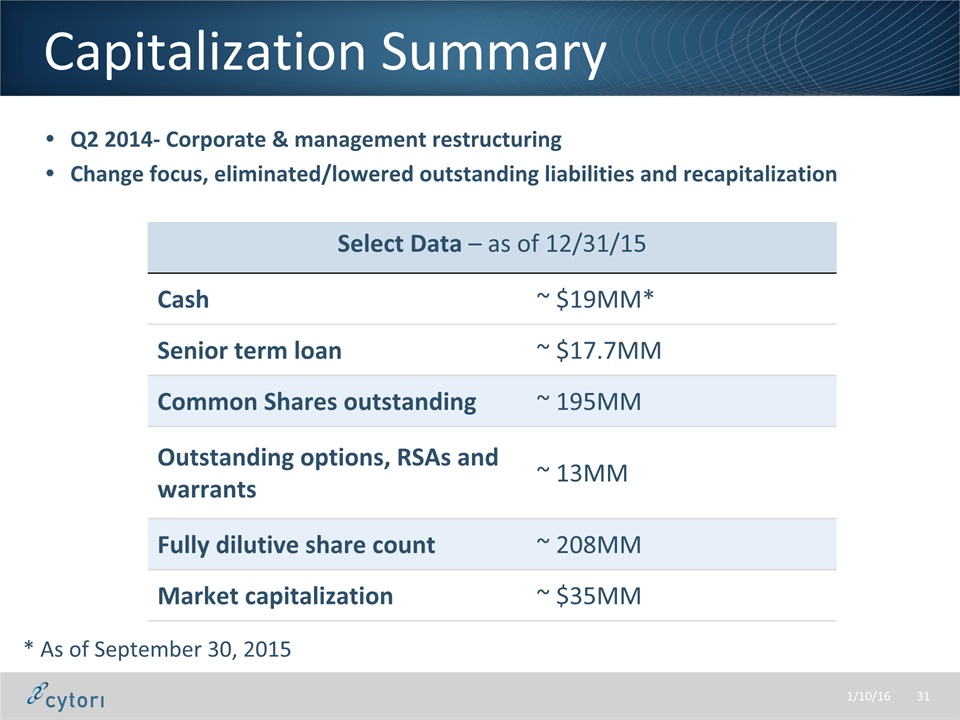
Capitalization Summary Select Data – as of 12/31/15 Cash ~ $19MM* Senior term loan ~ $17.7MM Common Shares outstanding ~ 195MM Outstanding options, RSAs and warrants ~ 13MM Fully dilutive share count ~ 208MM Market capitalization ~ $35MM 31 * As of September 30, 2015 1/10/16 Q2 2014- Corporate & management restructuring Change focus, eliminated/lowered outstanding liabilities and recapitalization

Financial & Operational Performance * Based on revised guidance of $22 million in operating cash burn for 2015** Based on annualized figures from YTD September 30, 2015 financials 32 1/10/16
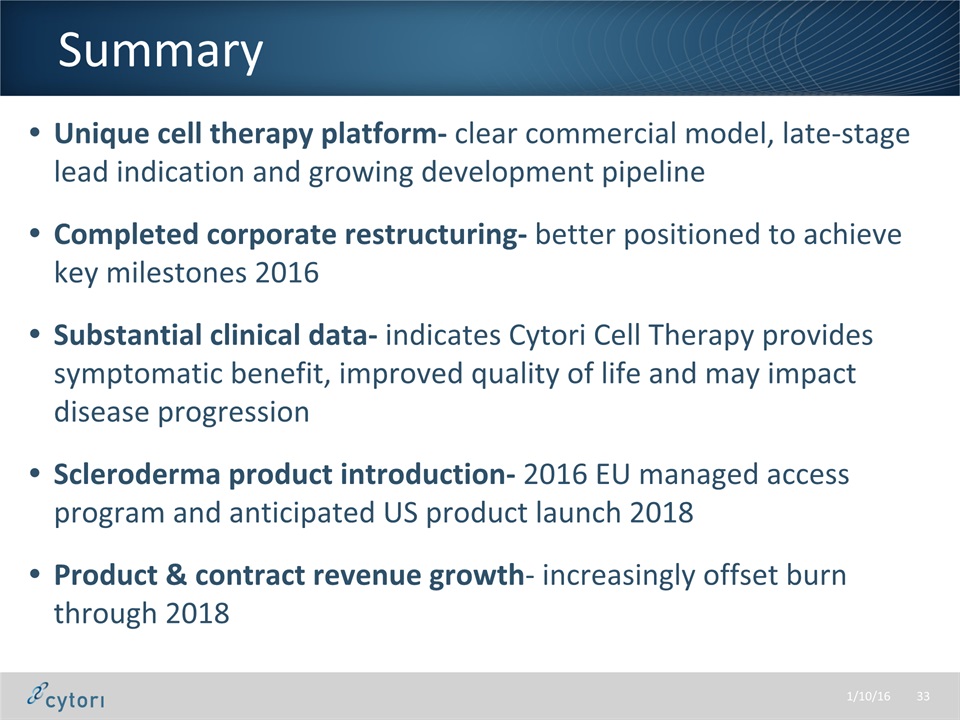
Summary Unique cell therapy platform- clear commercial model, late-stage lead indication and growing development pipeline Completed corporate restructuring- better positioned to achieve key milestones 2016Substantial clinical data- indicates Cytori Cell Therapy provides symptomatic benefit, improved quality of life and may impact disease progressionScleroderma product introduction- 2016 EU managed access program and anticipated US product launch 2018Product & contract revenue growth- increasingly offset burn through 2018 33 1/10/16

Review Cytori Corporate Milestones 2016 Milestones 1st Half EU MAP program launch24 WK ACT-OA interim data evaluation2 YR follow up data SD-I presentedFull STAR enrollmentFull SD-II enrollment 2nd Half 48 WK ACT-OA data evaluationJapan & MAP progress reportedSD-II data evaluation 34 2017 Milestones 1 YR follow up STAR evaluationFile US FDA PMA approval sclerodermaFile EMEA approval sclerodermaUS Phase I Burn enrollmentFull ADRESU enrollment

Thank You
